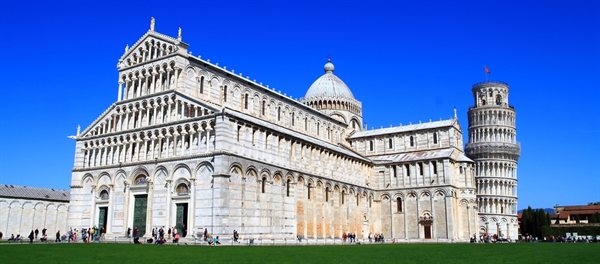Of ancient origin, Pisa was Roman naval base in the Middle Ages and the rich and powerful maritime republic.
An ally of the Normans in the conquest of Sicily, is the author of the First Crusade, which is the acquisition of commercial bases in the Mediterranean.
Ally of Barbarossa, gets in a feud Sardinia, Corsica and the coast from the mouth of the Magra to those dell'Albegna: the twelfth century is the period of its maximum splendor.
After his fleet is destroyed by the Genoese at the Battle of Meloria, falls into the hands of Florence and from that point follows the fate.
What to visit:
The Piazza del Duomo, or Field of Miracles, contains the monuments for which the city is famous all over the world, arising from a green lawn as if by magic: the Duomo, the Campanile, the Baptistery and the Cemetery. The Cathedral, the highest expression of the Romanesque-Pisan, was begun in 1064 and completed by 1118 by Buschetto by Rainald, with sloping façade crowned by four orders of loggias. The walls are decorated with mosaics, glazed tiles, plumes and roses, culminating at the top with the Madonna by Andrea Pisano. Inside, the pulpit by Giovanni Pisano (1311), in the center hangs the so-called ("lamp of Galileo"), in bronze, whose oscillations would have made sense to the scientist the isochronism of the pendulum. Not far away stands the bell tower, known worldwide as the leaning tower, tilted about 5 degrees, with six rows of loggias around the cylindrical structure. The tower was built from 1173, interrupted for a century for the land subsidence and completed in the mid-300. Opposite the cathedral, stands the majestic Baptistery from the lawn, started in 1152 by Diotislavi to be completed two centuries later. Inside, the famous pulpit by Nicola Pisano in 1260. The Cemetery is a rectangular building, with a porch that runs around the lawn, where in the eleventh century was laid the earth brought from Golgotha. It houses the tombs of prominent residents, as well as a collection of Roman and medieval sculptures, including the tombs of Tino Camaino and Andrea Guardi. In the square, the museum of the Opera del Duomo. To complete the knowledge of the '200 and '300 Pisa, visit the National Museum of S. Matthew, at the convent of the same name on the river bank. Crossed the river on the bridge of Middle, the oldest in the city, you come to the beautiful Piazza dei Cavalieri, the center of the republican city, with the building of the Caravan, the church of St. Stephen to the knights and the palace of the clock. Also worth seeing are the churches of S. Catherine, and St. Maria della Spina, a jewel of Romanesque-Gothic style with statues of Andrea and Nino Pisano.
Additional Info
Published in
Destinations
